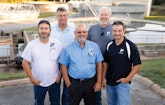
Tom Myers has worked on the drinking water side but likes the challenges that go with the complexity of biological treatment processes.
Tom Myers has reaped many rewards from a 43-year career in the clean-water profession. He’ll be the first to tell you he didn’t do it on his own.
Myers has gained a great deal — and has helped many others — through deep involvement with industry associations, from the time he got his start in Iowa until today, as wastewater superintendent in Siloam Springs, Arkansas.
Throughout the years he has thrived on relationships with counterparts in other communities, members of his own team, engineering firms, state lawmakers and regulators, and representatives of industries that send pretreated wastewater to his treatment plant.
“We don’t always have all the answers,” says Myers, winner of a 2019 William D. Hatfield Award from the Arkansas Water Environment Association. “It’s great to be able to ask someone from another plant, ‘What are you doing about this problem?’ They may have an awesome idea that we didn’t think about. And it works the other way around too. Hopefully we can give them some insight on issues they are facing.”
Relationships certainly helped during construction of a new treatment plant and process in 2009-10 to meet stricter limits on phosphorus discharge to the Illinois River, which is designated as a scenic river after it crosses into Oklahoma.
Appealing career
Growing up in Fort Dodge, Iowa, Myers took an interest in the environment. The Clean Water Act took effect in 1972, and career opportunities in wastewater treatment abounded as new plants were built and existing plants upgraded their processes.
Myers earned an environmental science degree from Iowa State University in 1976 and was drawn to the water sector. “It was either water or wastewater treatment I was thinking about,” he recalls. “I just really liked the wastewater side. There’s a lot to treating drinking water, of course, but in wastewater there are so many complexities. There’s the microbial activity and the biological science, as well as the hydraulics and mechanics. And then you’ve got the maintenance on all that equipment.”
He started his career with an internship in Sioux City, Iowa, and then became plant manager in Carroll for seven years. He moved to Creston as plant manager and was promoted to Public Works director. After 20 years there, he left Iowa for Siloam Springs, where he has been for 18 years.
Situated on the Oklahoma border, Siloam Springs has grown from about 8,000 population when Myers arrived to nearly 20,000 today. It’s the home of John Brown University (just 600 feet from the treatment plant), has a historic downtown area and has a thriving arts community anchored by the Sager Creek Arts Center and the John Brown University art gallery.
Treatment flexibility
When Myers came on board, the treatment plant used contact stabilization and trickling filters. A new effluent phosphorus limit of 1.0 mg/L drove the need for the new plant, designed by Garver engineering with the University of Cape Town process, combining anaerobic, anoxic and aerobic sections for biological nutrient removal. The plant has a design flow of 5.3 mgd and an average flow of 3.1 mgd.
The headworks includes a 6 mm bar screen (Parkson Corp.) and a fixed bar screen followed by basic grit channel where WEMCO pumps (Trillium Flow Technologies) provide grit removal. “We have two primary clarifiers, but because our process needs 30 mg/L of BOD typically removed there, we bypass them and go directly to a BNR splitter,” Myers says.
The biological process consists of three trains, each with three anaerobic, four anoxic and three aerobic cells with a mean cell retention time of about 19 days. The process lends flexibility to introduce return activated sludge at different points as required to optimize nutrient removal. After the BNR process, the flow moves on to a pair of 1.2 million-gallon final clarifiers, sodium hypochlorite disinfection and dechlorination with sodium bisulfite before discharge.
Waste activated sludge is sent to a storage tank, thickened from 0.5% to 1% to 2% solids, and delivered to five aerobic digesters for an extended aeration time of 100 days or longer. The digested material is dewatered to 23%-25% solids on a 2.5-meter belt press. The dewatered material is trucked to a landfill for use as night cover.
Making a transition
The switch to a new process was challenging, but made easier by communication between the Garver consultants and Myers’ team, which now includes:
- Tony Brown, foreman with six years of service and a Class III operator license
- Hector Aranda, with 17 years and a Class III license
- Jon McKain, with 13 years and a Class II license.
“We let them tell us what they were thinking and what technologies we should use to achieve our goals,” Myers says. “Garver wanted city personnel to be involved in the design process. It’s very important to have buy-in from the city staff on any improvements. That way they become involved. They take pride in it, and they know firsthand how it’s supposed to work.”
The Siloam Springs plant team helped select the University of Cape Town process; its flexibility held considerable appeal. Before making the selection, team members visited other treatment plants in the area to evaluate their performance and costs.
The city received a State Revolving Fund loan of $20 million for the $24 million project and paid for the facility with a temporary local sales tax of 0.625%. During the Obama administration, the city qualified for $4 million stimulus funds. “I was involved in establishing the sales tax,” Myers says. “Rather than have our residential and industrial customers see a significant rate increase to pay for the improvements, we went with the sales tax.
“We paid the 20-year note off 12 years early, in part because of all the growth in our community. After that, the sales tax went off. We could have extended it, but we didn’t need it anymore. Now we’re looking at $31 million in improvements to the water plant, and the taxpayers said, ‘Rather than raise our rates, let’s go ahead with the sales tax.’”
Building connections
Myers attributes ideas like that, and much of his career success, to connections he has forged over the years. His time in Creston helped him appreciate communication. As Public Works director, he had to work closely with the City Council and administrator: “Good communication means addressing issues upfront, instead of letting things fester until you have a major upset.”
Early on in his career, he got involved in the Iowa WEA and its committees. That included chairing safety and government affairs committees; he now chairs the safety committee of the Arkansas WEA.
“By affiliating with the Water Environment Federation and state associations, you have outreach to other municipal agencies,” he says. “You get a kinship with others, and the sharing of knowledge with fellow association members has been really, really helpful. Sharing experiences and working with surrounding cities is always important. They have a lot to offer.”
There’s a vibrant wastewater community in the Northwest District of the Arkansas WEA. It includes an annual all-day meeting in Siloam Springs every August, as well as rotating monthly meetings at 11 cities where attendees earn continuing education units. That’s in addition to the statewide annual joint meeting of the Arkansas Water Works and Water Environment Association.
Team chemistry
Myers encourages his team members to follow his lead and get involved in association work. That includes Brown, who is expected to take over as wastewater superintendent when Myers retires in the next year or two and who was scheduled to take his Class IV operator license exam in September 2019.
Meanwhile, communication looms large in the way Myers leads his staff. “I hate to micromanage,” he says. “As a leader, you need to be able to sit down and talk to them. They have to be on board.”
His approach includes significant cross-training: “Because of the size of our plant, we have the opportunity to let our employees do the laboratory analysis, as well as run the belt press and handle plant operations. There’s value in getting them actively involved, taking ownership, giving input, being part of the big picture.”
Myers’ outreach extends to the state level, where he strives for open communication with regulators. “It’s not a perfect world. We all make mistakes. It’s important to have strong relationships with the regulators so you can confide in and trust them, and they can do the same with you.” The state Department of Environmental Quality and Department of Health are deeply involved in WEA meetings, offering classes on safety, emerging regulations and more.
Through WEA Government Affairs committees, Myers has worked with state legislators to influence regulations. As committee vice chairman in Arkansas, he was part of a group led by chairman Heath Ward, utility director in Springdale, that pushed through legislation to enable state-level nutrient trading. More recent, he has worked on a proposal to win tax exemptions on equipment for water treatment plants; that remains a work in progress.
As he looks toward retirement, Myers offers simple, yet powerful advice to people working their way up in the water professions. “Get involved,” he says. “Read trade magazines. They contain a lot of good articles about what other cities have achieved. Stay on top of new technology. Always open your horizons. Set goals for where you want to be, and where you want your facility to be, 10 or 20 years down the road.
“Be active in your associations. It’s so rewarding, not so much to get recognition as to build relationships with others in the industry, state agencies and cities in your area. You’ll find there is always a need. Either you can help somebody or they can help you.”
Dealing with industry
Siloam Springs, Arkansas, has a robust industrial base that includes poultry and meat processing, canning, rubber vulcanizing and pet food production.
Many of those facilities deal with high-strength wastewater; Tom Myers and the municipal treatment plant team keep the influent loading stable with a thorough pretreatment program. “We allocate BOD based on our headworks loading rates,” says Myers, wastewater superintendent. “Then we make sure they are in compliance by requiring monthly reports and by going out and checking the industries, doing random testing to verify their analysis.”
Here again, communication and relationships come into play. “We need to have them as our allies,” Myers says. “They make mistakes. When they do, we want them to let us know.” For example, if notified of a plug load that could shock the plant, Myers and his team can adjust the process or divert the flow to an equalization basin used for high flows from storm events.
“By having those relationships, we can alleviate potential problems,” Myers says. “Like any facility, they can have a pump break down or an operator error. If they hurry up and notify us, we can minimize the effect.”







